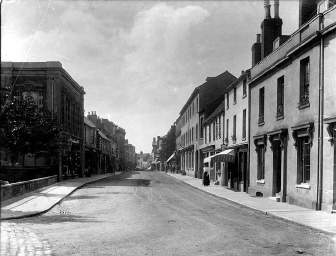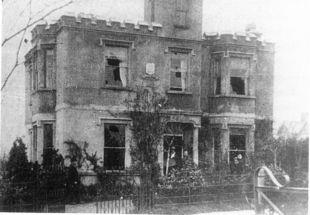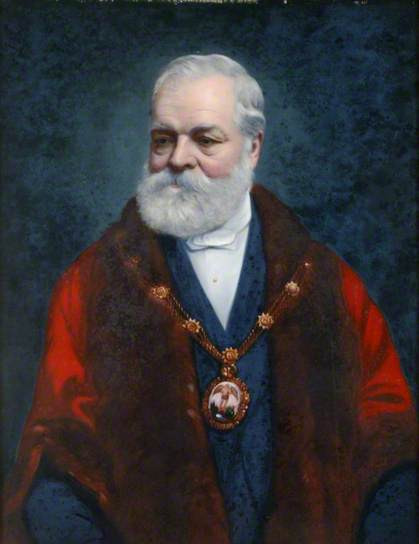
 Scenes from Basingstoke and the Area
Scenes from Basingstoke and the Area
Gunmakers of Basingstoke
The wedding of John Howlett Beatley and Laura Whistler took place at the Berkshire village of Aldermaston on 29 May 1826 (1). John was the son of William and Keziah Beatley of Norwich, Norfolk (2). Laura, born on 2 March 1807 and baptised at Aldermaston on 29 March 1807, was the daughter of John Whistler, a ‘plumber and glazier’, and his wife Elizabeth.
Sadly, John Whistler had died in a building accident in the year before Laura’s wedding. Laura’s mother Elizabeth became a widow for the second time – her first husband George Patterson had passed away in 1800. Elizabeth’s daughter Sarah Patterson, the half-sister of Laura, had become the wife of Richard Soper at a marriage ceremony in Aldermaston on 9 December 1816. Richard and Sarah Soper were the two witnesses on the marriage certificate of John and Laura Beatley.
The 1844 Pigot’s Commercial Directory for Basingstoke listed both John Beatley and Richard Soper as gunmakers on London Street. John Beatley also qualified as a whitesmith (a tinsmith) (3). Before the railway era, London Street and Winchester Street formed the main road through Basingstoke along which stage coaches regularly passed on the Winchester to London route. In the Victorian period, London Street was the address of thriving shopkeepers (4).
 |
London Street, Basingstoke, Hampshire. Looking west along the street, lined with Georgian shops and houses. Photograph by Henry Taunt, 1890, from View Finder  , , Historic England Archive. |
The parish register for St Michael’s Church, Basingstoke, records the baptisms for fourteen children of John and Laura Beatley (5). When John Howlett Beatley passed away in 1857 his eldest son John Charles Beatley was employed as an ironmonger in Cirencester, Gloucestershire. It was the younger son Charles Beatley who took over the Basingstoke gunmaking business. In 1860 Laura remarried and she settled with her new husband, Robert Harrison Wake, in Wargrave, Berkshire. Laura died in Wargrave on 11 September 1867 (6).
The Hampshire Museums and Archives Service in Winchester has a collection of billheads for the Beatley family business (7). For example, a bill for the Revd Hasker dated 13 September 1834, was printed with the description:
| London Street, Basingstoke J. H. Beatley, Gun-Maker Bell Hanger, Brass Worker, etc. |
|
and Sole Manufacturer of Brownjohn’s Patent Cap Charger. Percussion and other Fowling Pieces, with London proved Barrels, finished throughout on the most esteemed Principles. Percussion Caps, adapted for the above Chargers of superior Quality. Fishing Apparatus of all Kinds, of the best Manufacture. Articles of Brass Work cleaned and lacquered. Agent for the Portable Oil Gas – fittings neatly and expeditiously executed. |
Thirty years later, in 1864, Charles Beatley delivered a bill to Lord Bolton that advertised:
| London St, Basingstoke Charles Beatley Gun Maker & Fishing Tackle Manufacturer, Tin Man, Whitesmith, Working Cutler & Repairer of Steel Trusses, Archery of Every Description, etc. |
|
Percussion & other Fowling Pieces, with London proved Barrels,
finished throughout on the most esteemed Principles.
Percussion Caps, adapted for the above Chargers of superior Quality.
Gun Powder, Shot, etc. Fishing Apparatus of all kinds, of the
best Manufacture. Articles of Brass Work cleaned & lacquered.
Gas fittings neatly & expeditiously executed.
Fitter up of invisible fences in parks, pleasure grounds, gardens etc. and wire working of every description, in brass or iron. Copper and tin ware, in every variety. |
It appears that the young Beatley had a struggle making a success of the business. On 10 March 1865 The London Gazette reported the bankruptcy of Charles Beatley of London Street, Basingstoke, ‘Gun Maker, Bell Hanger, Fancy Wire Worker, Brazier and Cutler’ (8). At the time of the 1871 census, the two brothers John Charles Beatley and Charles Beatley were living with their families in West London and they both reported their occupation as ‘gas fitter’.
Their brother George Beatley, a typesetter in the printing trade, also settled in London. Another brother William Beatley worked as a gunmaker and ironmonger in Witney, Oxfordshire where he also had an interest in photography like his cousin John Whistler (more discussion is in the section Victorian Photographers).
John Burgess Soper
John Burgess Soper, the eldest son of Richard and Sarah Soper and, like the Beatley brothers, a grandson of Elizabeth Whistler of Aldermaston, was born in 1820 in Padworth, a neighbouring village to Aldermaston (9). He became the owner of an iron foundry on Basingstoke Wharf at the terminus of the Basingstoke Canal (10).
A directory for 1880 listed John Burgess Soper as the superintendent of the Basingstoke Fire Brigade and an ‘engineer & founder, manufacturer of every description of hot water apparatus, pumps &c. Basingstoke ironworks; London depot, Vauxhall station’. A review of his career, printed in the local newspaper in July 1881, stated that he had resided in Basingstoke for 57 years, had been in business as an engineer and ironmonger for 34 years, and first entered the Town Council in 1866 (11).
At the 1881 census the Soper family were living in their newly built house named Hillside in the South View area of Basingstoke. Later in the year, on the day of the municipal election of 1 November 1881, the house was vandalised by a mob who resented John Burgess Soper’s support of the Salvation Army’s message on the abstinence of alcohol that aimed to curb the unruly drunkeness that was facilitated by the over 50 public houses in Basingstoke. The mob stoned the house, smashing the windows (12).
 |
Hillside, South View, Basingstoke. The home of John Burgess Soper after being vandalised during the Salvation Army riots in 1881. Photograph in Arthur Attwood, The Illustrated History of Basingstoke, 2001, p. 81. |
In the election held on 9 November 1888 John Burgess Soper, a supporter of William Gladstone’s Liberal party, was elected the mayor of Basingstoke for the upcoming year (13).
| John Burgess Soper, Mayor (1888–1889)
|
| by unknown artist, oil on canvas,
in the collection of Basingstoke and Deane Borough Council, presented to the Aldermen and Burgesses of Basingstoke by the sitter’s daughters, 1895; from the Art UK national collection of paintings  . .
|
The Basingstoke street names of both Burgess Road and Soper Grove were named after John Burgess Soper (14). In 1891 he established two almshouses on Chapel Street, Basingstoke. These were demolished in September 1965 (15). In 1989 Hillside, now vacant and decaying, was razed by developers (16).
At South View Cemetery an obelisk marks the burial ground of John Burgess Soper (17).
A conservation appraisal for the South View area of Basingstoke was accompanied by a historical review that included a comment on Soper: (18)
One man who appears to have been instrumental in the development of South View was John Burgess Soper, a local ironmonger who was in business as Soper and Cranston in Basingstoke Market Place. He gave his name to Burgess Road and Soper Grove, built Gladstone Villas in 1886, and Hillside, his own large residence on the site of what is now Sylvaner Court, in the late 1870’s. He also offered a number of sites between Darlington Road and the cemetery for the construction of the new Roman Catholic Church of the Holy Ghost at the turn of the century.
Appendix: Family History in Census Returns
The Beatley Family
The Soper Family
General References
- Shirley Dixon,
Who were the Sopers?,
Berkshire Family Historian, June 2023.
- Interesting reading is provided by an illustrated biography of
John Burgess Soper
 by the
Basingstoke Heritage Society
by the
Basingstoke Heritage Society  ;
and projects of the
;
and projects of the
Basingstoke Archaeological and Historical Society .
.
Notes
(1) Microfilm copy of the Aldermaston parish register at the Berkshire Record Office, Reading.
(2) In the 1851 census for Basingstoke the birthplace of John Howlett Beatley was identified as Norwich. The parish register for the church of St Gregory, Norwich records that John Howlett Beatley was born on 16 November 1801 and baptised 22 November 1801.
 |
| Extract from the parish register of St Gregory, Norwich
for baptisms in 1801:
John Howlett Beatley son of Wm & Kezia Beatley late Nobs born Nov 16th & Baptized Nov 22 (Norfolk Parish Registers images online at FamilySearch). |
A marriage licence for his parents, William Beatley and Keziah Knobbs,
was issued in 1793 by the Bishop of Norwich (Norfolk Record Office
online catalogue).
Kezia Nobbs, the daughter of Moses and Martha Nobbs, was
baptised at Mattishall, Norfolk on 2 May 1779 (FreeREG website).
(3) Historical Directories, University of Leicester Special Collections Online.
(4) Arthur Attwood, The Illustrated History of Basingstoke, Breedon Books, 2001, p. 49. Old photographs of London Street are given on pp. 67–71.
(5) Basingstoke baptisms for children of John
and Laura Beatley:
John Charles (19 January 1827),
George (17 March 1828),
William (12 July 1829),
Henry (19 June 1831),
Alfred (29 April 1832),
Henry (30 June 1833),
Laura (2 January 1835),
Alfred (26 March 1837),
Charles (13 February 1839),
Mary Ann (6 September 1840),
Laura (17 October 1841),
Fanny (7 May 1843),
Miriam (5 January 1846), and
Daniel (26 February 1847).
The baptisms were located at FamilySearch Historical Records online (batch number: C136542)
and checked from the parish register for St Michael’s Church,
Basingstoke viewed at the Vancouver Public Library from microfilm
ordered from the Family History Library in Salt Lake City, Utah.
The baptismal entries gave the occupation of John (Howlett) Beatley
as gunmaker / gunsmith.
For the baptism of Laura on 17 October 1841 the father’s name
was listed as William – it seems likely that the correct name was
John Howlett Beatley.
(6) Addresses of the sons of John and Laura Beatley were located on census returns available at the Ancestry website. The death of John Howlett Beatley was found at the FreeBMD website. The information about the remarriage and death of Laura was kindly provided by Susan Knight. The marriage register of St Dunstan’s in the West, London, recorded the wedding on 2 February 1860 of Robert Harrison Wake, widower, farmer, residence: Fleet Street, father William Harrison, farmer, and Laura Beatley, widow, residence: Basingstoke, father John Whistler (microfilm of parish register at the Guildhall Library, London). As a comment, Fleet Street, London, appears an unusual address for a farmer – so possibly this was a temporary address only.
(7) Martin Norgate, Directory of Hampshire Gunsmiths, Hampshire County Council Museums Service, 1993 (in the collection of the British Library).
(8) The London Gazette online historical archive.
(9) Information on the Soper family was kindly provided by Shirley Dixon and Barry Dixon.
(10) Richard Garfield,
‘
How champions of the past started  ’,
The Basingstoke Gazette (online edition), 24 February 2009.
’,
The Basingstoke Gazette (online edition), 24 February 2009.
(11) Kelly’s Directory of Hampshire, 1880 (accessed at Google Books online). Hampshire Telegraph and Sussex Chronicle (Portsmouth, England), Wednesday, July 13, 1881 (accessed from the British Library 19th century newspapers online).
(12) Arthur Attwood, The Illustrated History of Basingstoke, 2001, pp. 80–7.
(13) A list of new mayors printed in The Times, London, 10 November 1888 (accessed from the Times Digital Archive).
(14) Historical Miscellany of Basingstoke: Essays by George W. Willis, edited by Barbara McKenzie, 1972, pp. 76 & 79.
(15) Robert Brown, ‘Building homes for the needy’, The Basingstoke Gazette (online edition), 2 July 2008.
(16) Richard Garfield,
‘
How champions of the past started  ’,
The Basingstoke Gazette (online edition), 24 February 2009.
’,
The Basingstoke Gazette (online edition), 24 February 2009.
(17) Richard Garfield,
‘
Cemetery reveals borough’s history  ’,
The Basingstoke Gazette (online edition), 22 March 2007.
’,
The Basingstoke Gazette (online edition), 22 March 2007.
(18)
South View Conservation Area Appraisal,
Basingstoke and Deane Borough Council, May 2006 (accessed at the website:
Basingstoke and Deane
Borough Council  ).
).
| Copyright © WhistlerHistory All Rights Reserved. |
Disclaimer
Revision date: 2024 |
